一 : (列举法)
Unit Four Section A How to Make a Good Impression
I. Objectives
1. Skills:
1)reading: read for the main ideas in paragraphs, understand the paragraphs supported by details,examples.
2)writing: understand how to support the general statement with details and examples and how to use questions to introduce a topic
3)listening: understand passages talking about how to make a good impression, listen for the main idea and major details, learn how to deal with the new words in the listening materials
4)speaking: talk about the importance of first impression and the ways of making a good impression on others, prastise the conversational skills about how to express regret and about how to show sympathy
2. Vocabulary development
1)Words : instant, assume, acquaint, partial, aggressive, resentful, status, aspiration, project, promote, conviction, economic, rigid, norm
2)Expressions: to make up our minds about, a chain of reactions, to range from?to?,an encounter with a stranger,to (be) focus(ed) sth.on, to read sb,to hold the interest of others,to form an impression about sb.,to (be) base(d) sth. on,to be committed to, to be absorbed in, to impress sb. with, to fix one’s eyes on / upon , to drive everyone crazy,to be at one’s best, to change from one situation to another,to match their words, three words into the sentence, to break eye contact,to be like going into a lion’s cage,to keep my eye on the lion,to get to me, to take ? too seriously, with one’s whole being ,lighten up, lack of, in relation to, pick up,in part, account for, feel at home, be content with, a wealth of
3. Grammar
1.Typical patterns for starting a topic through evidence or questions
2.Typical patterns for argumentation through a list of examples
3.Typical patterns for argumentation through“if” clause
II. Teaching Arrangement
1.Total class time for this unit: 8 periods
2. Suggested arrangement:
1) pre-reading activities: 15'
2) understanding the structure of text A: 25'
3) detailed study of the language: 30'
4) grammar: 20'
5) exercises: 35'
6) reading skills: 15'
7) detailed study of the language of text B: 30'
8) writing skills: 10'
9) comprehensive exercises: 45'
1
10) supplementary reading and vocabulary exercises: 45'
11) listening : 90’
III. Pre-reading Activities
Qestions and Answers
1. How long does it take us to judge the people we meet?
2. How do we judge a person?
3. How can we make a good impression on others?
4. What is the key to being the best person you can be?
IV. Understand the Main Idea of the Text and the Devices to Develop It Main idea of the text ?
When people want to make a good impression, the following advice can be of some help: you are the message; be yourself; use your eyes; and lighten up.
Devices for developing it?
1. Listing (列举法) The writer successfully presents the reader his ideas through the device of listing:
He gives his four pieces of advice on “How to Make a Good Impression” by listing and expounding one after another:
You are the message. (Para.3)Be yourself. (Para. 6)Use your eyes. (Para.10)Lighten up. (Para. 12)
2. Questioning(设问法)The writer presents and expounds his ideas by asking a list of questions, thus arousing an active echo in the reader’s mind, and then bringing the reader round to his ways of thinking.
3. Exemplification (举例法)Exemplification is applied to make the author’s advice or opinion more authentic and persuasive. And it is employed in the second part of the article as follows:(Para.3) (Para.12-13)
V. Understand the main idea of each part and the devices to develop it Part I (Para.1-2)
Main idea : Research shows that we make up our minds about people through unspoken communication within seven seconds of meeting them.
Devices to develop it:
Listing (列举法)
Consciously or unconsciously, we show our true feelings with ____ ____, _____, ______ and __________, causing a chain of reactions, ranging from _______ to ____.
Questioning (设问法)
Set a scene:Focus on the first seven seconds.
What did you feel and think?
Part II(Para.3-14)
Main idea:The four qualities we can use to impress others:you are the message; be yourself; use your eyes; lighten up
Devices to develop it:
Deduction (演绎法)
General statement 1 :
2
Be yourself.
Specific deduction:
Many how-to books advise you to stride into a room and impress others with your qualities. They instruct you to greet them with “power handshakes” and tell you to fix your eyes on the other person. If you follow all this advice. You’ll drive everyone crazy ―including yourself. Part III(Para.15)
Main idea: We all have within ourselves the power to make a good impression. Just be ourselves and we’ll make it.
Devices to develop it:
Induction through Questions & Answers (归纳法Paragraph 15)
VI. Understand expressions and patterns
A. Expressions:
1.to make up our minds about sb. 1)对某人的判断 2) 决心, 断定 make up one’s mind to do sth/ make up one’s mind that ...;2. a chain of reactions 一连串的反应;3. range from?to?: 从??到?? cf vary from?to?;4. an encounter with a stranger 与陌生人的一次邂逅;5. to (be) focus(ed) sth. on 把(精力/注意力)集中于; 6. to read sb. 解读某人7. to hold the interest of others 吸引住他人的兴趣8. to form an impression about sb. 对某人形成一种印象9. to (be) base(d) sth. on以??为某事的基础10. to be committed to sth/doing sth 致力于??be devoted to, be dedicated to,11. to be absorbed in集中精神,专注于??be caught up in, be involved in, be lost in, be engaged in, be immersed in12. to impress sb. with以??给某人留下深刻印象leave/ make a (good, deep) impression on sb. (with sth.), impress sb. with sth./impress sth. on sb.13. to fix one’s eyes on / upon 目不转睛地注视?? 14. to drive everyone crazy使所有的人都受不了15. to be at one’s best处于全盛时期,在最佳状态 cf to be at one’s worst16. to change from one situation to another随着情况的变化而改变17. to match their words (他们的音调和手势)与所说的话一致18. three words into the sentence一句话刚说了几个字??19. to break eye contact中断目光接触20. to be like going into a lion’s cage 就像走进了一个狮子笼21. to keep my eye on the lion注视着那头狮子 cf to keep an eye on sth.22. to get to me走到我身边23. to take ? too seriously对??过于认真
24. with one’s whole being 全身心25. believe something over something相信?胜过?26. lighten up使轻松愉快
B. Patterns for you to use as models
1. Typical patterns for starting a topic through evidence or questions
1) A large body of research (evidence / study / facts / experience / data) show(s) (proves / suggests / indicates)that?(从句--Topic) 大量的研究(证据/ 研究/事实/经验/数据)显示(证明/表明),??
2) Do sth. Question 1, 2, 3?做某事(设定情景) ¢围绕此情景设问(引出话题)
应用: 想一想毕业后的职业追求。哪种职业可以充分发挥你的专业技能?哪种职业可帮助你实现你的人生价值?哪种职业可确保你名利双收?这些是所有在校大学生将要面临的问题。Set your mind on the
pursuit of careers upon graduation. Which career will give full play to your professional skills? Which career will help realize your life value? Which career will ensure both fame and wealth for you? These are the questions all the undergraduates will have to be faced with.
2. Typical patterns for argumentation through a list of examples
1) Sb. does one thing, does another thing, ?(a list of examples). The secret / basic problem is that?(作者的观点)
应用: 你可以梦想当一名土木工程专家,当一名生物学家,甚至当一名地球物理学家。但根本的问题是你 3
有什么条件去圆一个又一个的梦。You can dream of becoming a civil engineering expert, a biologist and even a geophysicist. But the basic problem is what qualities you have to realize one after another of your dreams.
2) Sb. / Sth. is the same (Sb. does sth.)whether ?, ? or ?(a list of examples). 无论是??时,??时, 还是??时,某人/ 某物的表现是一样的(某人仍做某事)
应用:不论他身体是否舒适,不论天气是好是坏,也不论其他人是否能按时到办公室上班,我的父亲总是很守时。
My father is always punctual whether he is sick or not, the weather is nasty or not, or the others can make it to the office on time or not.
3) Whether ?, ? or ?, always remember to do sth. 不管??, ??, 还是??, 始终记住要??应用: 不管在事情进展得顺利时,还是在事情进展得不顺利时,始终记住你要保持清醒的头脑,避免盲目乐观或过分悲观。Whether things go right or wrong, always remember to keep cool, avoiding blind optimism or undue pessimism.
3. Typical patterns for argumentation through“if” clause
1) Sb. will (not) do sth. if / as long as / provided ? (说话者的情景设定) 只要/如果??某人就(不)会??
应用:如果你不努力学习的话,你就不会有什么出息。If you don’t work hard at school, you will hardly get anywhere.
2)If / Even if (though) sb. did (even) sth., he / she needs (doesn’t need) to do sth. else. 哪怕/即使某人做了某事,他/她也需要(也不必)做另一事。(提出建议)
应用: 哪怕你只有一门考试过关,你也大可不必灰心丧气。Even if you passed only one of the exams, you don’t need to lose heart.
3)If I did do sth, I certainly wouldn’t do sth. (like that). I would do it (the other way around). 就算我做某事,我肯定不会?... 我会??(现身说法)
应用:就算我追求爱情,我肯定不会只顾沉浸在爱河里而荒废学业。我会将爱情融入我的学习之中。If I did hunt for love, I certainly wouldn’t bathe myself in the river of love all the time, neglecting my studies. I’d integrate my love into my studies.
4
二 : 列举法

特性列举法 列举法
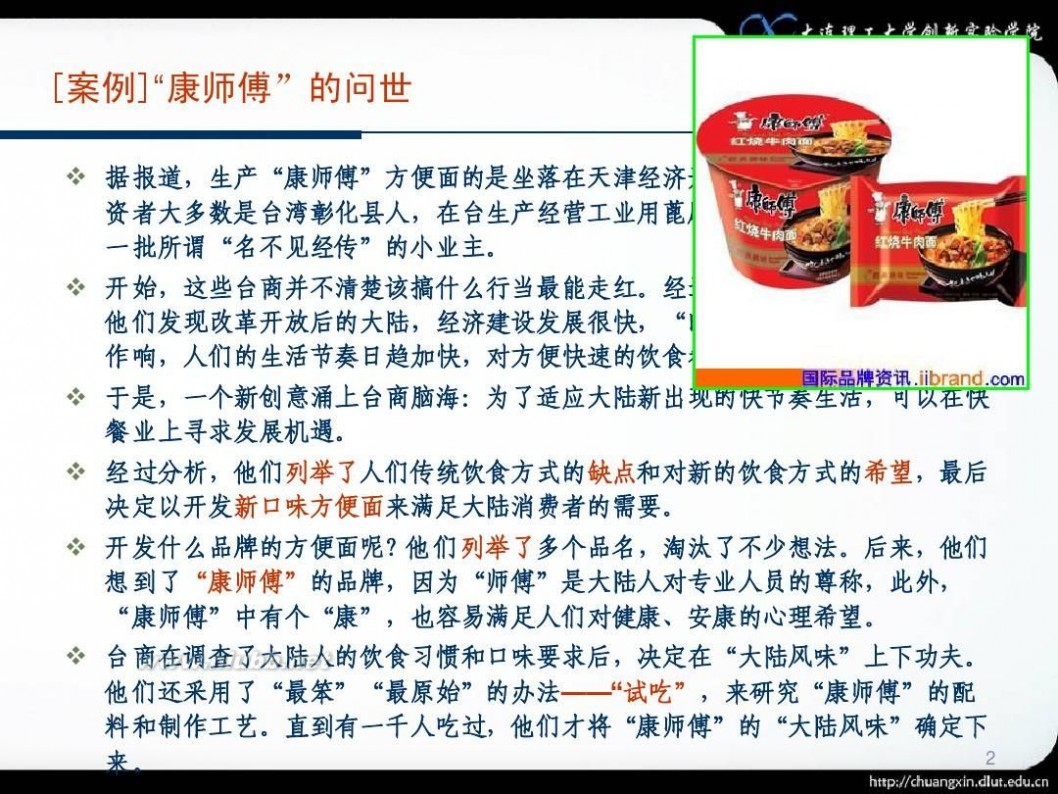
特性列举法 列举法

特性列举法 列举法
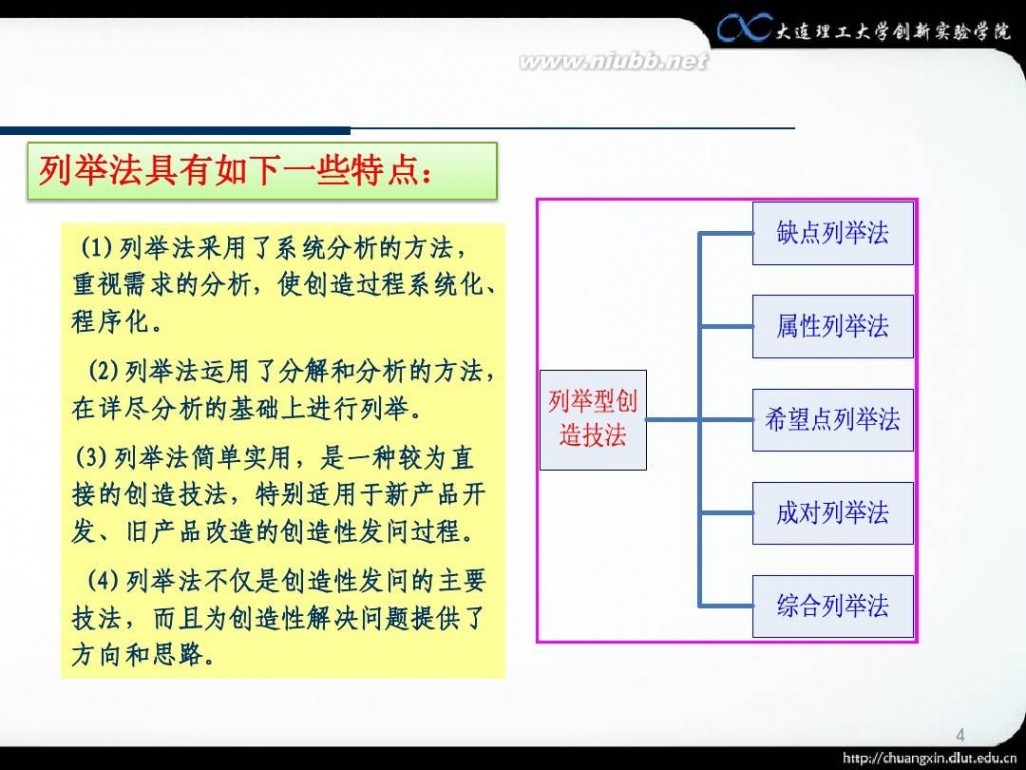
特性列举法 列举法
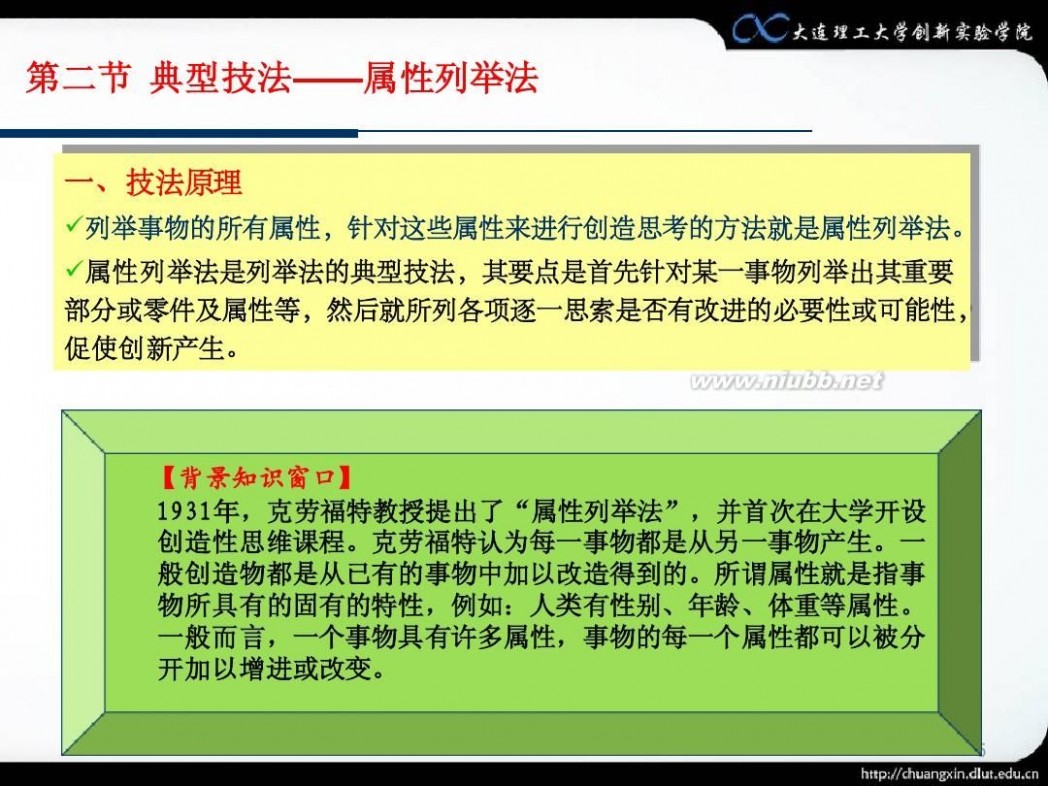
特性列举法 列举法
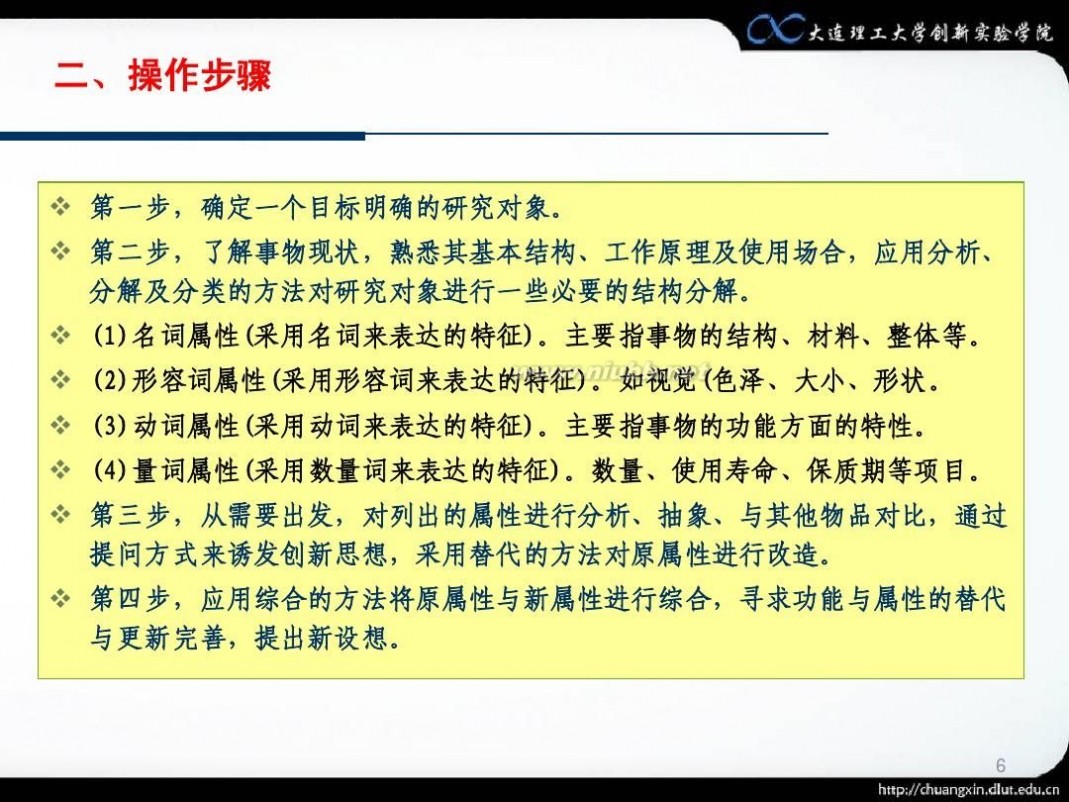
特性列举法 列举法

特性列举法 列举法

特性列举法 列举法
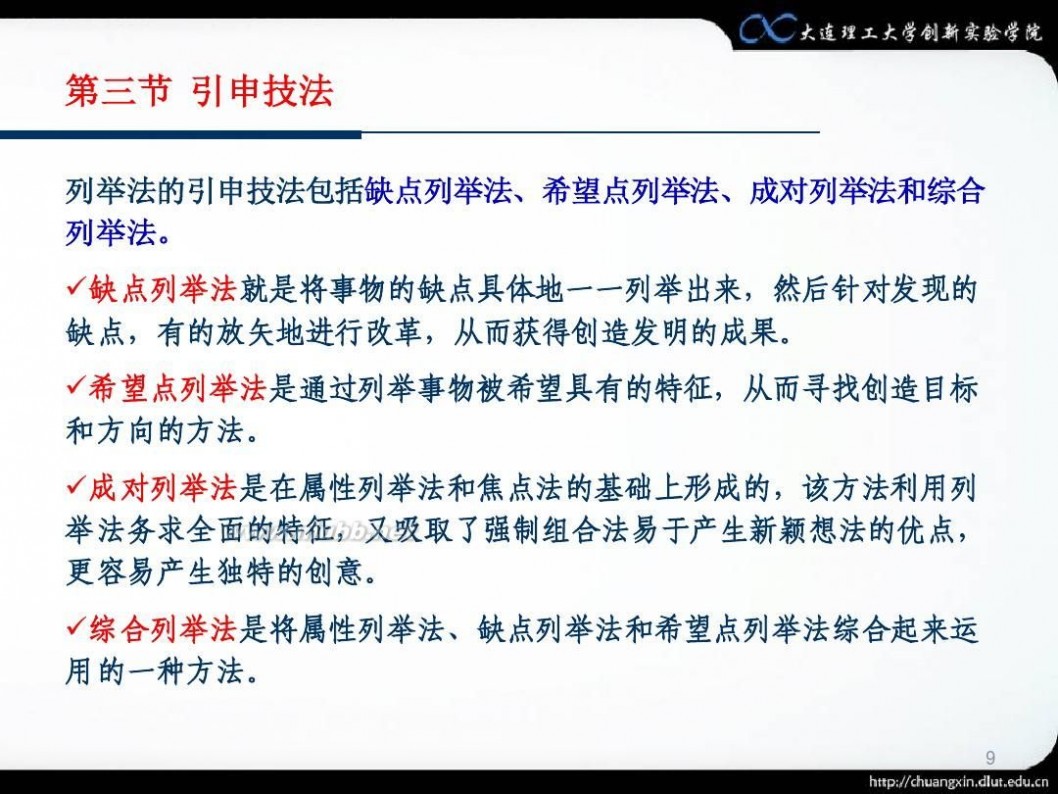
特性列举法 列举法
[www.61k.com)61阅读提醒您本文地址:
三 : 三种列举法
61阅读/ www.61k.net
600学生用杯子配合伴奏的歌曲 When I'm gone as Gaeilge
三种列举法
一、缺点列举法
缺点也是创造要素。 ——帕内斯 ? 缺点就是问题。解决问题的前提是发现 缺点、找出问题。 ? 缺点列举法的原则,就是从“有什么缺 点需要改进?”来找出更好的办法。
? “缺点列举法”是针对某个产品 (或事物),通过一定会议(头脑 风暴法),尽可能多地列举出它的 缺点,然后在这基础上,找出主要 的缺点加以改进。这种方法能激励 人去革新和创造。
以伞为例
常用伞的缺点: 遇上大风会“吹顶”; 布面遮挡前方视线 易遗忘丢失; 伞尖容易刺痛人; 拿伞的手不便于再提别的东西; 乘公共汽车时伞上的水会沾湿别人的衣服; 回家要撑开、晾干; 伞骨容易折断; 伞布透水,裤脚易被雨水打湿; 花样少,样子一样,不容易识别等。
针对上述种种缺点,制伞工厂研制出各式各样的 伞: 便于收藏、携带的折叠伞; 伞面用透明塑料不挡视线的伞; 伞布经防处理的不透水的伞; 伞布有多种图案便于识别的伞; 适合于两人用的椭圆形伞; 伞顶加集水器,收伞后雨水不会漏在车内的伞; 张开方便的自动伞; 伞柄内装电筒便于夜间行路的照明伞; 伞柄内装半导体收音机可边走边收听节目的伞, 等等。
背肩式雨伞
能充电的伞
分叉伞
防盗雨伞
? 雨天,从户外进入室内活动,往往需要 将雨伞放置在出口处,因为只能依靠出 入行人的自觉,所以不乏雨伞被盗的情 况发生。这款防盗雨伞的伞把部分可以 从雨伞主体上拆卸下来,如此一来,应 该不会有小偷取用这把「不好用」的雨 伞了吧?
请思考:汽车的缺点
还有吗?
? 1、左转弯 ? 2、夏天 ? 3、前面有大货车
女司机错踩油门 撞垮保安亭
? 重庆晚报讯 昨晚7点50分左右,江北区 洋河三村中翰名苑小区,一名女司机驾驶一辆 还没上牌照的红色大众轿车,不小心挂伤停靠 在路边的一辆奥迪轿车,惊慌中,误把刹车当 油门,把不远处的保安亭撞垮,正在值班的两 名保安受伤,所幸无生命危险。 ? 中翰名苑小区居民胡世海介绍,大众轿车 的左侧门被撞凹,前方引擎盖被撞变形。估计 女司机吓傻了,几分钟后才摇车窗从副驾驶室 爬出来。
错踩油门应急装置
作品:嵌入式分级汽车报警系统
请思考:拖把的缺点
请思考:拖把的缺点
? ? ? ? ? 1. 2. 3. 4. ...
请思考:眼镜的缺点
? ? ? ? ? 1. 2. 3. 4. ...
小练习
? 1、请你列举几样物品(如电脑、手机等) ? 2、试着找出它们的缺点(越多越好) ? 3、请大家踊跃发言。
二、希望点列举法
“希望点列举法”是根据
提出来的种种 希望,经过归纳,沿着所提出的希望去 进行创造的方法。
? 希望批举法是从发明者的意愿提出各种 新的设想,它可以不受原有物品的束缚, 因此,它是一种积极、主动型的创造发 明方法。 ? 可采用“头脑风暴法”。
拿晾衣架设计为例
? 什么样的晾衣架才会受到顾客的欢迎呢?
壁挂式
山形
能拉伸
实践应用
? 1、希望点可以加以在时间上前伸,如未 来30以后的设计 ? 例如:30年以后的手机会怎样? ? 50年以后的汽车会怎样? ? 100年以后的电脑会怎样?
新颖的发明以色列发明未来电脑
44
智能汽车会怎样?
? ? ? ? ? 1 2 3 4 5
与TRIZ理论最终理想解结合
? ? ? ? ? 2、由希望点延伸到理想化 例如: 理想化的窗户是怎样? 理想化的水杯会怎样? 理想化的茶几会怎样?
技术系统进化法则之四 提高理想度法则 ? 最理想的技术系统:“它既不消耗任何资源, 但却能够实现所有必要的功能”(作为物理实 体它并不存在) ? 技术系统是沿着提高其理想度,向最理想系统 的方向进化 ? 提高理想度法则是所有进化法则的基础。 理想化意味着: ? 系统的质量、尺寸、能量消耗 0 ? 实现的功能数量 ∞
47
测量金属腐蚀度的理想方案
、
传统设计者 ? 铂金容器 ? 耗费资源 ? 耗费时间
48
最终理想解
? ? ? ? 利用已有资源 去掉容器 但能实现有用功能——盛酸溶液 腐蚀的有害作用自动消失
播放机向微观的进化
录音机
随身听
便携CD机
mp3
耳环 播放机
50
计算机从宏观进化到微观
102 101 100 10-1 10-2 10-3 10-4 10-5 10-6 10-7 10-8 10-9
量子计算机
51
最终理想解:
系统的进化总是向着更理想化的方 向发展,如果将创造性解决问题的方法 比作通向胜利的桥梁,那么最终理想解 就是这座桥梁的桥墩;
三、特性列举法
? 这种技法所采用的主要手段是,通过对 创造发明对象的特性的分析,一一列出 其特性,然后探讨能否改革以及怎样实 现改革的方法。
? 一般说来,要着手 解决或革新的问题, 越小越易获得成功。 ? 例如,要革新一辆 汽车,如将它分成 各个部分:发动机、 汽缸、车身、轮胎、 排挡、方向盘等等, 就比整体汽车要容 易提出新的设想, 从而也易找出问题 和改进的方法。
运用特性列举法的一般过程
? 第一步,选择一个目标比较明确的创造或革新 课题。课题宜小不宜大。如课题较大,可以分 解为若干小课题。 ? 列出创造或革新对象的特征。一般事物的特征 包括以下三个部分: ( 1 )名词特征 —— 全体、部分、材料、制造方 法; (2)形容词特征——性质、状
态; (3)动词特征——功能。
举例:改革一个水壶 (1)名词特征——采用名 词来表达的特性。 全体:水壶。 部分:壶身、柄、盖、 壶口、壶底、蒸汽孔。 制造方法:焊接法 、 冲压法。 (2)形容词特性——采用 形容词来表达的特性。 性质:轻、重。 状态:美观、清洁。 (3)动词特性——采用动 词来表达的特性。 功能:烧水、盛水、 倒水、浇水。
? 第二步,从各个特性出发,通过提问,诱发出 可用于革新的创造设想。这时,可采用智力激 励等方法,产生出众多的设想,然后通过检核、 评价,挑选出好的设想。 ? 在运用特性列举法时,对事物的特性分析,越 详细越好,并尽量从各个角度提出问题,得到 众多的启示。
谢谢
祝大家在创新活动中 取得丰硕成果
四 : 三种列举法
600学生用杯子配合伴奏的歌曲 When I'm gone as Gaeilge
三种列举法
一、缺点列举法
缺点也是创造要素。 ——帕内斯 ? 缺点就是问题。解决问题的前提是发现 缺点、找出问题。 ? 缺点列举法的原则,就是从“有什么缺 点需要改进?”来找出更好的办法。
? “缺点列举法”是针对某个产品 (或事物),通过一定会议(头脑 风暴法),尽可能多地列举出它的 缺点,然后在这基础上,找出主要 的缺点加以改进。这种方法能激励 人去革新和创造。
以伞为例
常用伞的缺点: 遇上大风会“吹顶”; 布面遮挡前方视线 易遗忘丢失; 伞尖容易刺痛人; 拿伞的手不便于再提别的东西; 乘公共汽车时伞上的水会沾湿别人的衣服; 回家要撑开、晾干; 伞骨容易折断; 伞布透水,裤脚易被雨水打湿; 花样少,样子一样,不容易识别等。
针对上述种种缺点,制伞工厂研制出各式各样的 伞: 便于收藏、携带的折叠伞; 伞面用透明塑料不挡视线的伞; 伞布经防处理的不透水的伞; 伞布有多种图案便于识别的伞; 适合于两人用的椭圆形伞; 伞顶加集水器,收伞后雨水不会漏在车内的伞; 张开方便的自动伞; 伞柄内装电筒便于夜间行路的照明伞; 伞柄内装半导体收音机可边走边收听节目的伞, 等等。
背肩式雨伞
能充电的伞
分叉伞
防盗雨伞
? 雨天,从户外进入室内活动,往往需要 将雨伞放置在出口处,因为只能依靠出 入行人的自觉,所以不乏雨伞被盗的情 况发生。这款防盗雨伞的伞把部分可以 从雨伞主体上拆卸下来,如此一来,应 该不会有小偷取用这把「不好用」的雨 伞了吧?
请思考:汽车的缺点
还有吗?
? 1、左转弯 ? 2、夏天 ? 3、前面有大货车
女司机错踩油门 撞垮保安亭
? 重庆晚报讯 昨晚7点50分左右,江北区 洋河三村中翰名苑小区,一名女司机驾驶一辆 还没上牌照的红色大众轿车,不小心挂伤停靠 在路边的一辆奥迪轿车,惊慌中,误把刹车当 油门,把不远处的保安亭撞垮,正在值班的两 名保安受伤,所幸无生命危险。 ? 中翰名苑小区居民胡世海介绍,大众轿车 的左侧门被撞凹,前方引擎盖被撞变形。估计 女司机吓傻了,几分钟后才摇车窗从副驾驶室 爬出来。
错踩油门应急装置
作品:嵌入式分级汽车报警系统
请思考:拖把的缺点
请思考:拖把的缺点
? ? ? ? ? 1. 2. 3. 4. ...
请思考:眼镜的缺点
? ? ? ? ? 1. 2. 3. 4. ...
小练习
? 1、请你列举几样物品(如电脑、手机等) ? 2、试着找出它们的缺点(越多越好) ? 3、请大家踊跃发言。
二、希望点列举法
“希望点列举法”是根据
提出来的种种 希望,经过归纳,沿着所提出的希望去 进行创造的方法。
? 希望批举法是从发明者的意愿提出各种 新的设想,它可以不受原有物品的束缚, 因此,它是一种积极、主动型的创造发 明方法。 ? 可采用“头脑风暴法”。
拿晾衣架设计为例
? 什么样的晾衣架才会受到顾客的欢迎呢?
壁挂式
山形
能拉伸
实践应用
? 1、希望点可以加以在时间上前伸,如未 来30以后的设计 ? 例如:30年以后的手机会怎样? ? 50年以后的汽车会怎样? ? 100年以后的电脑会怎样?
新颖的发明以色列发明未来电脑
44
智能汽车会怎样?
? ? ? ? ? 1 2 3 4 5
与TRIZ理论最终理想解结合
? ? ? ? ? 2、由希望点延伸到理想化 例如: 理想化的窗户是怎样? 理想化的水杯会怎样? 理想化的茶几会怎样?
技术系统进化法则之四 提高理想度法则 ? 最理想的技术系统:“它既不消耗任何资源, 但却能够实现所有必要的功能”(作为物理实 体它并不存在) ? 技术系统是沿着提高其理想度,向最理想系统 的方向进化 ? 提高理想度法则是所有进化法则的基础。 理想化意味着: ? 系统的质量、尺寸、能量消耗 0 ? 实现的功能数量 ∞
47
测量金属腐蚀度的理想方案
、
传统设计者 ? 铂金容器 ? 耗费资源 ? 耗费时间
48
最终理想解
? ? ? ? 利用已有资源 去掉容器 但能实现有用功能——盛酸溶液 腐蚀的有害作用自动消失
播放机向微观的进化
录音机
随身听
便携CD机
mp3
耳环 播放机
50
计算机从宏观进化到微观
102 101 100 10-1 10-2 10-3 10-4 10-5 10-6 10-7 10-8 10-9
量子计算机
51
最终理想解:
系统的进化总是向着更理想化的方 向发展,如果将创造性解决问题的方法 比作通向胜利的桥梁,那么最终理想解 就是这座桥梁的桥墩;
三、特性列举法
? 这种技法所采用的主要手段是,通过对 创造发明对象的特性的分析,一一列出 其特性,然后探讨能否改革以及怎样实 现改革的方法。
? 一般说来,要着手 解决或革新的问题, 越小越易获得成功。 ? 例如,要革新一辆 汽车,如将它分成 各个部分:发动机、 汽缸、车身、轮胎、 排挡、方向盘等等, 就比整体汽车要容 易提出新的设想, 从而也易找出问题 和改进的方法。
运用特性列举法的一般过程
? 第一步,选择一个目标比较明确的创造或革新 课题。课题宜小不宜大。如课题较大,可以分 解为若干小课题。 ? 列出创造或革新对象的特征。一般事物的特征 包括以下三个部分: ( 1 )名词特征 —— 全体、部分、材料、制造方 法; (2)形容词特征——性质、状
态; (3)动词特征——功能。
举例:改革一个水壶 (1)名词特征——采用名 词来表达的特性。 全体:水壶。 部分:壶身、柄、盖、 壶口、壶底、蒸汽孔。 制造方法:焊接法 、 冲压法。 (2)形容词特性——采用 形容词来表达的特性。 性质:轻、重。 状态:美观、清洁。 (3)动词特性——采用动 词来表达的特性。 功能:烧水、盛水、 倒水、浇水。
? 第二步,从各个特性出发,通过提问,诱发出 可用于革新的创造设想。这时,可采用智力激 励等方法,产生出众多的设想,然后通过检核、 评价,挑选出好的设想。 ? 在运用特性列举法时,对事物的特性分析,越 详细越好,并尽量从各个角度提出问题,得到 众多的启示。
谢谢
祝大家在创新活动中 取得丰硕成果

61阅读| 精彩专题| 最新文章| 热门文章| 苏ICP备13036349号-1